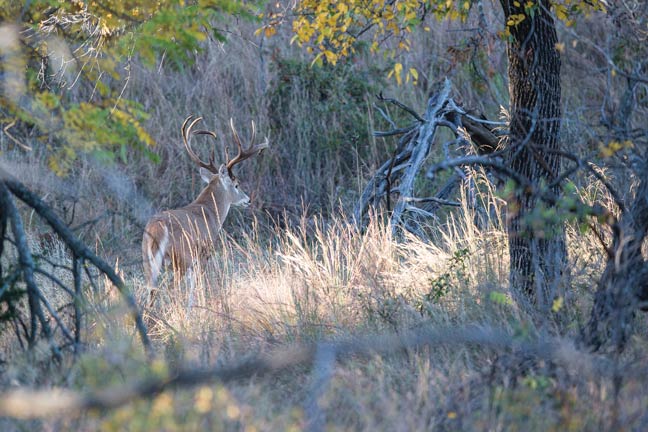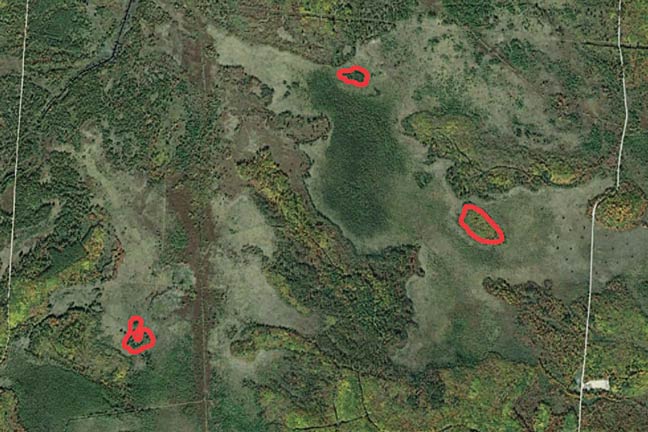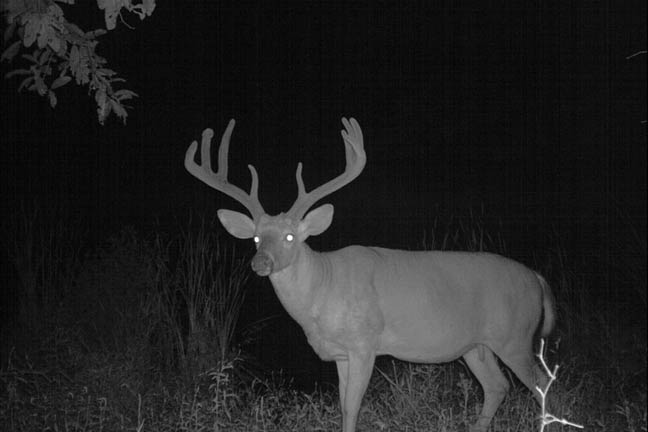I had to do a triple take. It was the afternoon after firearms season had closed, yet the buck sauntering through the wide-open food plot wasn’t just mature — he was ancient. When my Mathews eventually sent the arrow into flight, there was still over an hour of shooting light left.
I hadn’t climbed into stand that day with the idea of killing this buck. He’d always lived on the public ground across the fence. It wasn’t until my tag was on him that I figured out what had happened: Firearms season had pushed him into the sanctuary on my side of the line.

The right sanctuary can make even a savvy buck feel safe moving around in broad daylight. Photo by Tim Carr
He’d never felt pressure here; the sanctuary likely gave him the false sense of security to believe he was safe. That was, until he saw me at full draw, a split-second before I released that Easton.
Habitat management has caught fire over the last 10-20 years, to the point almost every serious hunter who controls ground puts in food plots. A high percentage also do various timber stand improvement work, plant trees and native grasses, create water holes and make other improvements.
Any of these can be effective. Of course, they also can be a ton of work and cost good money. Unfortunately, too many people believe it has to be that way. They also believe the other popular myth, that only big acreages benefit from this work.
Tragically, it causes many to believe they don’t have the time, cash or acres to make improving their hunting grounds worthwhile. The dirty little secret is that many great improvements can be made without much out-of-pocket expense at all. Some of them don’t take much time, either. And almost all of them benefit the smaller landowner even more than the one hunting acreages approaching four digits in size or more.
Creating sanctuaries is the perfect example, in that it requires no work or money. Even better, on more hunting grounds than not, no other single action can help your hunting more.
DEFINING SANCTUARIES
By my definition, a sanctuary is an area of deer cover I try to keep generally free of human disturbance from at least a month before any season opens until the final season closes. I might enter it occasionally during season, but I’d better have a really good reason to do so, such as to retrieve a deer.
The goal is to provide bedding areas where deer feel as safe as is practically possible. In turn, the sanctuary feeds adjacent areas of your hunting grounds with relaxed deer to hunt, as well as providing a powerful magnet of the promise of safety within its confines.

Even hard-hunted public land has sanctuaries holding older bucks. In these spots (marked in red), you can take a far more aggressive hunting approach than you’d employ on private land. Photo courtesy of Steve Bartylla
Although it’s not an iron-clad rule, I typically make areas offering higher-impact hunting into sanctuaries. That lessens the disturbance, most often sucking in pressured deer from surrounding properties while still offering high-probability hunting in low-impact locations.
For us to get the most benefit from a sanctuary, it must be big enough for the deer using it to feel safe. That five acres of pines surrounded by stands likely won’t do much good being set aside as sanctuary, as it’s too hard to consistently hunt the edges undetected. On the flip side, a 5-acre island in a swamp might be sufficient.
Still, the larger the sanctuary, the more potential good it typically does. In fact, when creating plans for photo evaluation or long-term management clients, I typically set up 70-90 percent of deer cover as sanctuary. Taking that much potential hunting ground off the table might sound like a bitter pill to swallow, but the results can be sweeter than most imagine.
SANCTUARY BENEFITS
The sweetness comes from the borderline incredible results sanctuaries can produce. Deer simply are drawn to areas in which they feel safe. I see this over and over again on the public areas I hunt. Find areas other hunters leave alone and you’ll find most of the deer: particularly mature bucks.
For as much as we tend to complain about how our neighbors hunt their ground, with them being sloppy hunters, killing everything that moves, sanctuaries can turn those same people into our best friends. What are those hunters doing every time they get winded, kick deer while going to their stands an hour before dark, decide to do some in-season scouting or even shoot at that young buck we passed yesterday? They’re training local deer to feel they’re not safe on that ground.
Now, imagine that 30 acres of your adjacent 40-acre hunting ground constitutes a sanctuary. How long do you believe it will take the deer to realize they aren’t experiencing those life-threatening events inside that 30 acres? Speaking from a bunch of experience, the transformation takes far less time than one likely believes. Often deer start figuring it out within a week or two of the first year a sanctuary is created. Remember: This is their home. They have a pretty good feel for what happens in their homes, just as we do in ours.
Our sanctuary trains deer to feel safe on our ground. As a result, our sanctuary will start drawing pressured deer like metal to a magnet. In fact, when deer feel pressured on our or a neighbor’s ground, a well-thought-out and planned sanctuary sends them running to it more often than not.

As hard as it is to avoid hunting most of your land, it can result in more bucks on the property — and more daytime activity in open season. Proper food plot placement gives you a pattern to hunt. Photos courtesy of Steve Bartylla
The importance of this is hard to overstate. Most hunting lands get nothing but worse with each day they’re hunted over the course of a season. And the more sloppily they’re hunted, the worse they typically get. On the flip side, properties that offer deer the illusion of safety tend to draw more deer with each passing day of the season. Hunting the ground in a low-impact manner certainly helps that, and sanctuaries push it over the edge.
The other huge advantage of strategic sanctuaries is that they train deer that it’s safe to move more freely during daylight. Deer are really no different than your dog, in that negative and positive reinforcement literally trains them what to do and not to do. In the dog’s case, we train it to do what we want. In a deer’s case, we too often train it to do what we don’t want it to do. In the case of our hunting pressure, we shift more of a buck’s movement to after dark.
An analogy I often use is to imagine setting a bowl of food out for your dog and then hiding in the corner from 6 a.m. to 6 p.m. each day. During that time, whenever the dog approaches the bowl to eat, imagine kicking it in the butt as hard as you can. How long do you think it will take before the dog stops feeding during those hours? Unless it’s a yippy little dog with a brain the size of a pea, not long at all.
That’s what sloppy hunting and a lack of a safe area do to deer. We train them that moving during daylight isn’t safe. The difference is that our training doesn’t leave them with a sore butt for not learning the lesson fast enough. It most often kills them.
On the flip side, a sanctuary trains deer that it’s safe to move inside without harm. After all, they aren’t seeing, smelling or hearing human predators inside its confines.
Add it all up and not only do sanctuaries have the power to draw more deer with each passing day of season, but they also encourage even those mature bucks to move during daylight. That’s a killer combination.
SANCTUARY GUIDELINES
One of the biggest challenges in writing about improving deer habitat is the inescapable fact that every piece of private land is different. Cookie-cutter approaches to habitat improvements just never work nearly as well as catering the improvements to the specifics of that ground.
The same applies to sanctuary creation. While one hunter might be best served to create a central sanctuary, another might benefit more from several. In one case you might benefit the most from having the sanctuary be in the center of the ground; in another, shifting it to the property line and hunting the center of the tract might be the best move.
In short, laying out exactly how each reader should create a sanctuary is impossible. Still, some guidelines can be very helpful:
* When you think it’s big enough, try to make it bigger. Your hunting is likely to improve by hunting less of your ground, not more of it.
* Start by converting all deer cover that can’t be hunted safely (that is, in a low-impact manner) into sanctuary. We’re doing our best to literally train deer they’re safe on our ground. That’s impossible to do when hunting high-impact stands.
* Because we want deer to use our sanctuaries as their daytime core areas, it’s helpful if these contain most of the best cover the property has to offer.
* Do your best to lay out the sanctuary so deer naturally want to run toward it, not away, if spooked by your hunting efforts.
* You also want them set up so they draw deer away from, not toward, hunting neighbors.
* Not only can sanctuary boundaries be adjusted to let you hunt low-impact stands in cover, they need to be. Doing so is a key to setting most cover aside for deer while continuing to be able to hunt it effectively.
* By default, sanctuaries will include some in-woods food sources, such as browse and possibly mast crops. However, you want to create them so most of the primary feeding areas are very close to, yet just outside, their boundaries. This makes taking advantage of increased daylight movement far more effective.
IN CONCLUSION
These sanctuaries cost nothing to build and take no effort, outside of the discipline required to mostly stay out of them. I say “mostly” because of course we want to enter them to retrieve any shot deer that get back into them before expiring.
We also want to scout these areas during the offseason. If we don’t, how can we be sure the “missing” buck we were chasing last year didn’t die over winter? Entering a sanctuary well outside deer season also lets us know if it needs some cover enhancements. Finally, by scouting it, we can determine how to better take advantage of the way in which deer are using that part of the property.

If a killer (yet higher-impact) stand location exists inside the sanctuary itself, I’ll set it up in spring. I obviously hope to fill my tags by hunting on the outside, but I save these special stands as aces up my sleeve. If I truly believe that I just can’t kill the buck I want from the outside, I’m willing to take a shot at hunting the sanctuary a time or two over the course of the full season.
But even then, I’ll only do so during the rut, in weather conducive to great deer movement, and will get in super early and sit all day. One or two hunts like that every few years can be pure magic.

